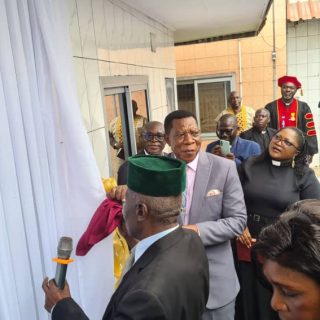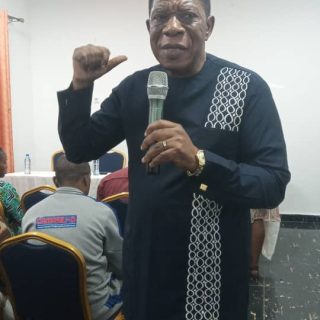Director Of Electricity At MINEE, Admits That The Takeover Of ENEO Cameroon By The State, Does Not Mean An End To LOAD SHEDDING

Unlike In The Days Of SONEL, Some Multinational Companies Have Today Joined The State In The Energy Production Sector In Cameroon. New Power Plants Have Been Constructed. In The Early 2000s, Less Than 1000 MW of Energy Was Produced And Distributed By SONEL. Today, The Total Capacity of Energy Plants, That Supply Energy To ENEO To Distribute, Is 2011 MW. Yet, There Is Load Shedding. Why Was There No Load Shedding, During The Days Of SONEL?

The national electricity company commonly known by its French acronym, SONEL, which was created in 1974 by the President of the then United Republic Of Cameroon, Ahmadou Ahidjo, was in charge of the production, transportation and distribution of energy (electricity) in the country. SONEL was the lone company in the country in the domains on energy production, transportation and distribution, and thus was a sort of monopoly in those three domains, which are interwoven.
SONEL maintained that status, even after the Government of President Paul Biya, in 2001, sold 51 % of the shares of SONEL to a US company, AES Corporation, which became the majority shareholder of SONEL, or the so called strategic partner of the State of Cameroon in SONEL. The remaining 5% of the shares of SONEL was supposed to go to the employees of the company. SONEL became known as AES SONEL.
The company however maintained its status as the lone company in charge of the generation or production, transportation and distribution of energy in the country. Worth noting that in the entire Southern part of the country (Southern Grid), SONEL as regard energy production, up to then depended on the two State owned hydroelectricity power stations at Edea and Songloulou, both in the Sanaga Maritime Division of today’s Littoral Region.
Worthy of note that AES Corporation in 2014 decided to sell its 51 % shares in AES SONEL to a British investment group, ACTIS, and the electricity company was given a new name, Energy Of Cameroon (ENEO Cameroon).
New Actors Enter The Electricity Sector
Meanwhile during the period of AES SONEL, the Cameroon Government along the line decided to open up the energy production sector to other actors, as it became clear that the two State owned hydroelectricity plants in Edea and Songloulou, could not meet up, with the rapidly increasing demand for energy by companies and the rapidly increasing population. The situation had become very difficult for Cameroon especially in the dry season, with the fall of the water level at River Sanaga that provides water to the dams at the Edea and Songloulou Hydroelectricity Power Stations. There was also the great need to have gas power plants that produces energy (electricity), to help especially during the dry seasons, to make up for the drop in production by hydroelectricity power stations.
That was how the Kribi Power Development Company, KPDC, and the Dibamba Power Development Company, DPDC (located in the outskirt of Douala), saw the light of day. The Dibamba Power Development Company is run by a consortium known as GLOBELEG. The majority shareholder of GLOBELEG is a partnership of a British company and Dutch Company. The KPDC and DPDC are power stations that produce energy from gas. These companies supply the energy they produce to the electricity distribution company, ENEO, for distribution to clients.
The New Hydroelectricity Power Plants
The Cameroon Government has built two new hydroelectricity power stations at Memve’ele in the South Region, and at Mekin in the East. The Government has also created another company, EDC, to manage the hydroelectricity plants owned by the State of Cameroon, like Memve’ele. Talking about the Memve’ele project, the Government made a lot of noise about it, when it was under construction. But upon completion, it fell below expectation. The project was reportedly forced on the Government by the current Minister of Finance, Louis Paul Motaze, who wanted the project to be in his native South Region, which is also the region of the President of the Republic, Paul Biya. All sorts of propaganda were made to project the purported rightness of the choice of Memve’ele for the costly project. It was said for example that the Memve’elle dams would put an end to the load shedding, because the dams will always be full throughout the year. But when the plant finally went operational, it turned out to be a disappointment, as it happens that the main river that supplies water to the plant or its dams is much more affected during the dry season, than the Sanaga River. And so during the dry season, the dams that were constructed at Memv’ele, do not have much water.
SONATREL In charge Of Transportation Of Energy

The Cameroon Government has also created a company is in charge of the transportation of electricity or energy from the different power plants, to the sub stations of ENEO in different past of the country, for distribution. It is thus SONATREL that is in charge of what is commonly known as high tension electricity transportation lines, that runs from one locality to the other. The electricity lines in towns and villages that transport energy to companies, to homes or to clients, are low tension lines, and are under ENEO. So SONATREL has monopoly in the transportation domain, just as ENEO has monopoly in the distribution of energy in the country.
The Nachtigal Hydroelectricity Power Plant
Meanwhile, the biggest hydroelectricity power station that has been constructed in the country since the Government opened the energy production sector to the private investors, is the definitely the Nachtigal Hydroelectricity Plant at Bachenga in the Centre Region. The Nachtigal Power Station that was inaugurated last year has seven turbines (engines), and a capacity to produce 420 MW of energy. The power station is owed by a consortium, Nachtigal Hydroelectricity Power Company, NHPC. The shareholders of the consortium include French Energy, International Finance (a World Bank institution), and the State of Cameroon among others.
Companies In The Energy And Transportation Companies, Depend On ENEO For Revenue
The fact is that many Cameroonians do not know how complicated the electricity sector in Cameroon has become, with many actors now involved. All these energy production companies as well as the energy transportation company, depends on the money from the electricity that ENEO distributes or sells, as their revenue. So when a customer pays his electricity bill, the money does all belong to ENEO. There is a percentage of the money that is supposed to go to the company or companies that produced the energy, another percentage to the SONATREL that transported the energy, and then another percentage to the distributor which is ENEO. So when people do not pay their electricity bills, all these companies are effected and not only ENEO. That is why when ENEO is unable to clear the bills of these companies, it, is a big problem in the energy sector.

ENEO Is The Face Of The Electricity Sector, And Take All The Punches
Meanwhile, the face of the electricity sector that the public continues to see, is, ENEO Cameroon, that is today in charge only of the distribution of energy, and no longer involved in the production and transportation of energy. The only production plants, over which ENEO still has some control is the old Songloulou and Edea hydroelectricity stations.
But as the public face of the electricity sector, ENEO does not only take blame for any lapses that occur in the energy distribution domain, but also for any lapses that occur in the production and transportation domains. When for example there is power failure in a locality, because a fault or an incident has occurred in one of the energy production plants, or on a high tension electricity line, the population calls the name of ENEO, whereas the company in reality is not responsible.
For example, in the last few weeks in Yaounde and Douala, there were frequent power cuts often lasting for a number of hours. Many people blasted ENEO Cameroon, fuming that the company has already started load shedding, when the dry season is just about starting. Some people also targeted the Nachtigal Hydroelectricity Power Company for attack on the social media, following rumours on the social media that some of the turbines at the newly constructed Nachtigal Hydroelectricity Power Station, had problems. While ENEO silently took the punches as usual, the Nachtigal Hydroelectricity Power Company came out with a communiqué on November 14, 2025, in which the company pushed culpability for the power cuts that were occurring in Yaounde and Douala, to the State owned national electricity transportation company, SONATREL. NHPC disclosed that SONATREL still has problems on the line that transport energy from the Nachtigal Hydroelectricity Power Station to Yaounde, and then on to Douala.
The fact is that with the construction of the big Nachtigal Hydroelectricity Power Plant, SONATREL needs a bigger line to transport energy from the power plant to Yaounde, and on to Douala. But SONATREL is still managing with parts of the old line, as construction work of the new line is still to be completed. In a normal situation, SONATREL would have constructed the new transportation line, before the completion of construction work on the power station, which took a number of years to complete. But that was not done.
A New Phenomenon – Load Shedding
Meanwhile, AES Corporation faced lots of public criticism in the running of the energy production, transportation, and distribution company, AES SONEL. The management of AES SONEL became a target of strong criticisms by GICAM (business cartel), as well as by members of the public. The main point of discontent was load shedding, which AES SONEL practiced during the dry seasons. The company complained that the water level or volume at River Sanaga that host the two hydroelectricity stations (Songloulou and Edea), dropped during the dry season, and the available quantity of water in the dams, was not enough to run the hydroelectricity power stations at their full capacities.
That explanation was true. This reporter has had the opportunity to visit the Songloulou and Edea Hydroelectricity Power Stations a number of times. What AES SONEL complained then, and what happens today, is the same. Songloulou which is the bigger hydroelectricity plant has a total of eight turbines (engines). When the water level at River Sanaga is high, which means that the dams at the energy production plant are full, the plant operates at full capacity, which means that all the eight turbines are on. Much energy is thus produced or generated by the plant. But when the water level at River Sanaga drops during the dry season, the dams do not have enough water to run all the eight turbines. The management of the hydroelectricity station is thus forced to put off some of the turbines, which means that the power station then produces or generates less amount of energy. At times, the situation is so bad that only four of the eight engines, are on. With less amount of energy being produced, the distributor of electricity is thus forced to ration electricity supply.

Why Was There No Load Shedding Before
But what the public has so not been able to understand, is why there was no load shedding during the days of SONEL, when the company was 100 % owned by the State. The explanation that the different managements of the company from the time of AES SONEL under AES Corporation, to ENEO Cameroon under ACTIS, constantly gave, was that in the days of SONEL, the management of the company during the dry season gave priority to areas like the nation’s capital, Yaounde, the nation’s economic capital, Douala, and a few other towns, to the detriments of rural areas in particular. To be more precise, Cameroonians who were in the management of SONEL, and later continued in AES SONEL and later ENEO Cameroon, explained that during the dry season in the days of SONEL, most rural areas and even some semi urban areas used to go for months without electricity, as the management of the State owned company tacitly adopted the policy of prioritizing the nation’s capital (Yaounde), the nation’s economic capital (Douala), and a few other towns where there were ‘big people’, in the supply of electricity.
Thus when the water level at River Sanaga or at the dams of the two hydroelectricity power stations dropped during the dry season, the reduced amount of energy that were produced by these plants were channeled to Yaounde, Douala and the other few areas prioritized in the Southern part of the country, where there were ‘big people’, while the other areas went without electricity for months, and nobody cared.
But the management of AES SONEL and later ENEO Cameroon, explained that the policy of the mother companies, AES Corporation in the United States, as well as that of ACTIS in the United Kingdom, could not condone such discrimination or favouritism, and so the management of AES SONEL or ENEO Cameroon, could not follow the way the management of SONEL used to do things during the dry season, when the water level at the Senegal River, dropped.
Increase In Supply Of Energy, But The Demand Remains Higher
Meanwhile during the days of SONEL, up to when the when the Government during the period of AES SONEL opened the energy production sector to the private sector, and also constructed the Memve’ele and Mekin hydroelectricity power stations, the total amount of energy production in Cameroon was less than 1000 MW, or better still, close to 1000 MW. But with the construction of the Nachtigal, Memve’ele and Mekin hydroelectricity power stations which produce energy using water, as well as the construction by the Kribi Power Development Company and the Dibamba Power Development Company of energy production plants using gas, the energy production plants in Cameroon today have a total capacity of 2011 MW. The means that it has more than double the close to 1000 MW that was available in the early 2000s. It should be noted that Solar (energy) is also increasingly in use in Cameroon today by some individuals, and some institutions like councils.
There Will Be Load Shedding
![]()
Meanwhile, one of the reasons that many Cameroonians are happy with the State of Cameroon’s takeover of ENEO, is the hope that there will be no longer be load shedding or power rationing during the dry season by ENEO. But the truth is that the takeover of ENEO by the State does not takeaway, at least for now,0 the population’s nightmare (load shedding) during the dry season. First of all, ENEO is today just the distributor of energy. As distributor, ENEO distributes what the suppliers of energy, supply to it. ENEO is not in a position to increase production.
Speaking during the programme, ‘Libre Expression’ over Info Tv in Yaounde on Sunday, November 23, 2025, Madam Marthe Essoumba, the Director of Electricity in the Ministry of Water and Energy commonly known by the French acronym, MINEE, admitted that from a study which the ministry and partners carried out last August, there will still be load shedding during this dry season that is just beginning. She said while there has been a significant increase in energy production in the country in the last 25 years, there has also during the same period equally been a very high increase in demand for energy, due to the increasing number of enterprises including industries in the country, and of course the constantly increasing population of the country. She said the ministry is being transparent to the Cameroonian people, and so does not want to deceive the population that there will be no load shedding.
Suspension Of Energy Production
One of the problems too is that some of these companies that produce energy from gas, which is very helpful during the dry season, when the energy production by hydroelectricity power plants drop due to water problem, at times suspend production, to press ENEO to clear accumulated bills. GLOBELEG, the majority shareholder that manages the Dibamba Power Development Company, during the last dry season for example, at one point shut down the production plant, and explained in a communiqué that due to the accumulated unpaid bill by ENEO, the company was unable to pay its workers and suppliers too. That was not the first time that GLOBELEG took such a decision. All the private companies in the energy production sector in Cameroon can do so, when put into very difficult situations by ENEO. As the Director of Electricity in the Ministry of Water and Energy, Marthe Essoumba, confirmed over Info Tv in Yaounde on Sunday, November 23, 2025, ENEO currently owes contractors, including suppliers, a total sum of between 450 – 500 billion francs CFA. How do these enterprises survive in such a situation!




